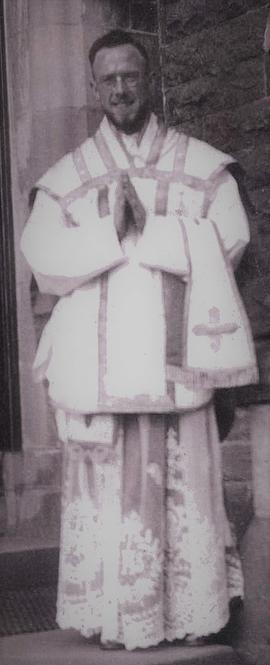James Murphy was born in Newry in County Down on 12 October 1912. He entered the Irish Capuchin novitiate in October 1930 and took Theodore as his religious name. He spent the three years of his simple profession in St. Bonaventure’s taking his BA degree in University College Cork. He made his solemn profession in October 1934. There followed four years of theological studies at Ard Mhuire Friary in County Donegal. He was ordained to the priesthood in June 1938. Following his ordination in St. Eunan’s Cathedral in Letterkenny, County Donegal, Fr. Theodore volunteered for missionary work abroad. At the invitation of Archbishop Sylvester Mulligan OFM Cap. he went to work with the English Capuchins in the Archdiocese of Delhi and Simla in India. He returned to Ireland after thirteen years of difficult missionary work (1938-51). Following a brief stint as Vice Master of Novices in Rochestown in County Cork during 1952, he was assigned to the Church Street community in Dublin for three years. He spent eighteen years teaching religion at the School of Marketing in Parnell Square in Dublin while residing in Raheny Hostel (1955-74). He was also superior of the Rahney community for three of those years (1958-61) as well as being an active promoter of the Seraphic Mass Association (SMA). In 1974, he was transferred back to Church Street and took up a chaplaincy role in St. Brendan’s Psychiatric Hospital. He continued in this role until 1979. He died in the Church Street Friary on 18 February 1993 and was buried in Glasnevin Cemetery.
Baptismal name: James Murphy
Religious name: Fr. Theodore Murphy OFM Cap.
Date of birth: 12 Oct. 1912
Place of birth: Newry, County Down (Diocese of Dromore)
Name of father: Thomas Murphy (Soldier)
Name of mother: Catherine Murphy (née McMahon)
Date of reception into the Capuchin Order: 3 Oct. 1930
Date of first profession:4 Oct. 1941
Date of final profession: 4 Oct. 1934
Date of ordination (as priest): 19 June 1938
Educational attainments: BA (1934)
Missionary activities: Travelled to the Archdiocese of Delhi and Simla on 3 Oct. 1938. He returned to Ireland in January 1952.
Date of death: 18 Feb. 1993
Place of death: Church Street Friary, Dublin
Place of burial: Glasnevin Cemetery, Dublin









